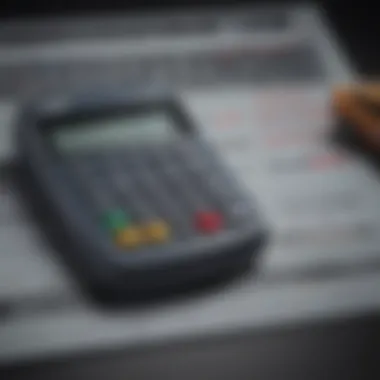Navigating Car Payments for a $22,000 Vehicle Purchase


Intro
Financing a car can be a complex process, especially when dealing with a vehicle priced at $22,000. Understanding what car payments entail is crucial for any prospective buyer. Many factors affect monthly payments, leading to confusion among buyers. However, by gaining clarity on key principles, purchasers can make informed choices that better align with their financial situations.
The significant aspects of car payments include understanding loans, credit scores, interest rates, down payments, and total ownership cost. Each of these components plays a role in what a consumer ultimately pays for their vehicle. The goal herein is to provide insights that empower individuals to navigate this purchasing process skillfully.
Overview of Car Financing
Car financing is essential for many individuals looking to acquire a vehicle, particularly for those purchasing a car priced at $22,000. Understanding the basic concepts involved in car payments equips buyers to make informed decisions regarding their financial commitments. This article aims to clarify various elements associated with auto financing, helping potential car owners navigate the often complex financial terrain.
Definition of Car Payment
A car payment is the amount of money that a buyer must repay to a lender for financing a vehicle. This payment usually consists of both principal and interest over a specified loan period. Typically, buyers enter a loan agreement with a financial institution to secure the funds needed to purchase the car. The common terms of the agreement include the duration of the loan, the interest rate applicable, and any other fees that might be incurred during financing.
When budgeting for a car, understanding the structure of car payments is critical. It helps assess how much can feasibly be afforded each month without compromising other financial responsibilities.
Key Components of Car Payments
Diving deeper, several key components come together to form a car payment. Recognizing these is crucial for prospective buyers:
- Principal Amount: This refers to the original sum of money borrowed to buy the vehicle. For a car priced at $22,000, if the buyer takes a loan for the full amount, the principal is exactly that.
- Interest Rate: This is a crucial element, often determined by creditworthiness and prevailing market rates. A higher interest rate leads to larger monthly payments compared to a more favorable rate.
- Loan Term Length: Usually, vehicle loans are spread over terms of 36, 48, or 60 months. Shorter terms typically come with higher payments but lower total interest costs over time, whereas longer terms slightly reduce each monthly payment while increasing overall interest payments.
In summary, the combination of these components directly influences the overall financial commitment when purchasing a vehicle. For anyone engaging in car financing, clarity on each of these aspects can significantly stabilize their financial path.
Determining Monthly Payments for a $22, Car
Understanding how to determine monthly payments for a vehicle priced at $22,000 is essential for any potential buyer. It's one of the first steps in budgeting for a new car and directly impacts financial planning. Selecting a car is already a significant decision; understanding payment obligations should not be overlooked. A clear grasp of monthly payments allows individuals to make informed structural financial decisions, potentially avoiding issues with unexpected expenses down the line.
Principal Amount
The principal amount is fundamentally the total loan supplied for the vehicle purchase before interest and fees are added. In our scenario, that number is $22,000. This figure serves as the starting point for loan calculations.
The principal loan amount itself is a major driver of the monthly payments you will face. Larger principal amounts lead to higher monthly payments. As finance works, overall loan costs are dependent on many factors surrounding this base number. Simply borrowing more increases the outlays. The correlation between principal and monthly payments cannot be ignored, revealed clearly by a direct numerical relationship.
Interest Rate Impact
Interest rates play a crucial role when determining the actual monthly payments of a $22,000 vehicle. Even a small difference in interest rates can dramatically change the overall costs associated with the loan. Typically, the amount you pay monthly increases as the interest rates do, directly affecting budget choices.
Low-interest loans can lower monthly payments significantly while reducing the total amount paid over time.
For instance, while financing can range from 3% to above 6%, the choice of interest rate can be informed by rebuilding ones’ credit or available incentives from certain dealers. Higher rates, in comparison, can become subsection of many recurring expenses over the term of a loan. This impacts planning for sufficient cash flow. Understanding prevailing market rates helps secure favorable terms.
Loan Term Length
The loan term length adds another layer of understanding when determining monthly payments. Car loans typically have terms ranging from 24 months to 72 months, or even longer in some situations. Longer terms might result in lower monthly payments, specifically distributing total financial outlay over a more substantial period of time.
However, that can lead to complications such as paying more interest over the life of the loan. Effectively, this creates a balance between affordability and long-term financial ironies. A short versus a long term, deciding factor would hypothetically stem from one's financial situation and whether living on borrowed resources suit the buyers' recurring obligations. Understanding this can guide buyers ensuring choices match their goals.
In effect, plates of monthly payments get formed owing to interplay nature of all the Loan term structure aspects. Every buyer needs to shape a plan of paying off their obligations, matching individual financial capability. Behavioral insight in money management sets apart mindful consumers from others in terms of financial satisfaction.
Calculating Your Monthly Payment
When purchasing a vehicle, knowing how to calculate your monthly payment is vital. With a vehicle priced at $22,000, understanding this figure allows buyers to plan their finances more effectively. It helps evaluate budgets and determines affordability. This section provides insights on reliable methods to arrive at this monthly payment. Every aspect of a loan directly influences that final sum. Therefore, potential car buyers should engage causally with these numbers.
Using Online Calculators
Online calculators are convenient tools for quickly estimating monthly car payments. Many automotive websites, financial institutions, and even dealerships provide these resources. To effectively use these calculcators, here are the elements typically needed:


- Loan Amount: Specify how much you will borrow, or for our case, the entire price of the vehicle.
- Interest Rate: Input the annual interest rate offered by lender whether it's favorable or not.
- Loan Term: State over how long you plan to repay the loan, commonly ranging from 36 to 72 months.
The broad advantage of using online calcul,ators is the immediate feedback on the options available. It provides varied scenarios based on slight changes in interests or loan terms. Some calculators even allow budgeting for tax and insurance costs. However, they are primarily estimates since they may not account for personal particulars like trade-ins, rebates, or special financing deals. For specific calculations and historical data, resources like britannica.com offer valuable insights.
Manual Calculation Method
While online resources are useful, mastering the manual calculation method is beneficial for a deeper understanding. This process requires a basic grasp of formulas used to determine car payments. The most common formula uses the principal, interest rate, and length of the loan:
Where:
M = Total monthly payment
P = Principal loan amount (the cost of the vehicle minus the down payment)
r = Monthly interest rate (annual rate divided by 12)
n = Number of payments (months)
To apply this method:
- Take the principal amount you intend to borrow. This is the full price less any down payments.
- Derive the interest rate by dividing your annual rate by twelve.
- Define the total number of payments by your chosen loan term in months.
Running computations like these can deliver clarity on your financial commitments. For an informed decision, consolidate all costs encompassing insurance premiums to assess monthly payments comprehensively. Understanding these figures firmly positions you during negotiation with lenders, enabling you to secure better a transaction.
Down Payment Considerations
A down payment serves as the initial, upfront payment made toward the total cost of a vehicle. For a $22,000 car, this is an essential part of the financing process. Its significance cannot be understated, as it affects several aspects of your car loan.
Importance of Down Payment
The down payment is crucial for multiple reasons. First, it reduces the overall amount of money you need to borrow. This reduction in principal amount directly affects your monthly payments and interest paid over the life of the loan.
Secondly, a substantial down payment may improve your chances of loan approval. Lenders typically view a larger down payment as a sign of financial responsibility, lowering the perceived risk involved in lending.
Additionally, making a larger down payment means you will have a lower loan-to-value ratio. This could lead to better interest rates. Lower rates help in mitigating the long-term cost of the vehicle.
A down payment also creates immediate equity in your vehicle. This is important since cars naturally depreciate in value. Starting off with some value in the car allows you to have a cushion if you need to sell or trade the vehicle for some reason.
"A thoughtful down payment significantly impacts your financing experience, structure, and overall costs over time."
Recommended Down Payment Amounts
It is generally advisable to make a down payment of at least 20% of the vehicle's value to maximize benefits. For a $22,000 vehicle, this translates to around $4,400. Making such a payment can provide the following advantages:
- Lower Monthly Payments: Reducing the amount financed lowers each month’s obligation.
- Better Loan Terms: Aiming for larger down payments might lead to favorable interest rates.
- Enhanced Equity Position: This can help in case of future trade-ins or loans.
However, individual finance situations vary. If 20% is a stretch, it is better to set a feasible target, rather than stressing over finances. Some options to consider include:
- 10% Down Payment: Approximately $2,200, still helping reduce the principal amount and improve loan standing.
- Higher Amounts: If possible, even above 20% may lead to stronger loan terms and payments.
Ultimately, every buyer should evaluate their financial reasons and aim for a down payment scheme that best lcrens with their budget and financial goals. Balancing upfront costs with monthly obligations is vital for a positive car ownership experience.
Credit Score and Loan Approval
Understanding the influence of credit scores on the car loan process is essential when financing your $22,000 vehicle. The credit score serves as a primary factor lenders consider when evaluating your eligibility for a loan. It reflects your creditworthiness and offers insight into your potential repayment habits, which can impact loan amounts and conditions.
Factors such as your payment history, amount owed, length of credit history, types of credit, and recent inquiries come together to form your credit score. Lenders usually categorize these scores into ranges to determine loan options. This background is necessary for assessing how much interest you will pay and what terms you will receive on the loan.
Impact of Credit Score on Interest Rates
The interest rate applied to your car loan significantly depends on your credit score. Higher credit scores often correlate with lower interest rates. Lenders view customers with excellent credit as low-risk borrowers, thus offering them optimal rates. Conversely, a lower credit score typically results in higher interest rates. This increase could cumulatively lead to substantial costs over the loan's life.
Here are some typical credit score impacts:


- 700+: Generally best interest rates available
- 650-699: Moderate rates, can still be favorable, but vary significantly by lender
- 600-649: Higher interest rates, increases monthly payments considerably
- Below 600: Potential rejection or significantly higher rates
A higher credit score can make car ownership much more affordable by influencing favorable financial decisions.
Getting Pre-approved for a Loan
Pre-approval is a strategic step that enhances your negotiating power when buying a vehicle. It offers insight into how much you can borrow based on your financial background and credit score. By getting pre-approved, potential buyers can avoid wasting time on vehicles that may exceed their budget.
There are several benefits to obtaining pre-approval:
- Sets a Budget: Helps you determine your price range clearly.
- Shows Seriousness: Dealer see that you have financing lined up, enhancing your credibility.
- Improved Terms: You may be more likely to negotiate favorable conditions.
To get pre-approved, you need to approach a lender of choice—typically traditional banks, credit unions, or online lenders—and provide information on your credit history and income. The lender checks your credit score and typically provides a document detailing the amount you can borrow. Pre-approval does not lock you into a loan but gives a clearer financial path before vehicle selection.
Remember, pre-approval will involve a hard inquiry on your credit yet can boost your overall loan terms if handled properly.
By ensuring strong credit scores and considering pre-approval, you significantly better your chances of favorable loan opportunities. This process reduces the anxiety related to financing, as you are armed with knowledge and clarity when it matmes to managing payment responsibilities.
Total Cost of Ownership
Understanding the total cost of ownership is crucial when purchasing a vehicle valued at $22,000. This perspective extends beyond the initial purchase price. It encompasses several components that affect your financial responsibility over time. Each factor plays an important role in maintaining your vehicle and ensuring it fits within your budget.
Insurance Premiums
Insurance premiums represent a significant expense for car owners. The cost of insurance may vary greatly depending on several factors including,
- Location: Urban areas typically incur higher premiums compared to rural regions.
- Driving History: A clean driving record may lead to lower rates, while accidents can increase premiums.
- Vehicle Type: The model of your vehicle influences premiums. Certain cars are deemed higher risk for theft or accidents.
Before finalizing your purchase, consider obtaining insurance quotes for the specific $22,000 vehicle you are eyeing. Understanding potential premiums allows for more accurate budgeting.
Maintenance and Repairs
Routine maintenance and unforeseen repairs will likewise impact the total cost of ownership. While the $22,000 vehicle in question may be new and come with warranties, these protections do not cover all expenses. Regular maintenance can include oil changes, tire rotations, and brake servicing. Over time, components will wear out and require replacement which can lead to surprising expenses.
Common considerations include:
- Warranty Period: Review what is included and what isn't covered after purchase.
- User Commitments: Plan for scheduled maintenance as outlined by the manufacturer. Ignoring this may lead to larger issues later.
By staying proactive in maintenance, you can avoid larger repair bills down the line.
Fuel Costs
Fuel costs fluctuates widely but fundamentally serves as an ongoing expense for all vehicle owners. Evaluating actual fuel efficiency—typically measured in miles per gallon (MPG)—is important when discussing a $22,000 car.
Driving habits impact fuel consumption significantly. Tips include:
- Monitor MPG Ratings: Check the official figures as reported by the manufacturer. Consider real-world reviews online.
- Driving Behavior: Smooth acceleration and braking often result in lower fuel usage. Frequent short trips may consume more, so consider errands in a single trip.
Overall, fuel costs can substantially influence the affordability of any vehicle. Calculating these from the outset leads to smarter buying decisions.
Understanding Vehicle Depreciation
Vehicle depreciation is a critical aspect of car ownership that often goes overlooked by buyers. Realizing how depreciation works can affect financial planning significantly when purchasing a car, especially an investment like a $22,000 vehicle. Understanding this phenomenon helps potential buyers anticipate their car’s resale value and determines the total cost of ownership over time.
Factors Affecting Depreciation
Various factors contribute to how much a vehicle depreciates over time. Some of the main elements are:


- Age of the vehicle: Generally, new cars lose value quickly. Significant depreciation often occurs within the first couple of years.
- Mileage: High mileage typically reduces a car's value faster. Generally, the more miles on the car, the lower its worth.
- Make and Model: Some brands and models hold their value better than others, due to reputation, reliability, and demand. More popular models tend to depreciate slower.
- Condition: A well-maintained vehicle will generally lose less value compared to one that has been neglected or involved in accidents.
- Market Trends: Economic factors or changing consumer preferences can affect depreciation. For example, a shift towards electric cars over gas-powered might impact their resale values.
- Alterations: Features or upgrades can sometimes enhance a vehicle's value. However, personalization often does not equate to increased market price.
Resale Value Considerations
When contemplating purchasing a vehicle, one must reconsider the implications of resale. The resale value can significantly impact the overall cost of ownership. Consumers should thoroughly assess these points:
- Time horizon: Understanding how long you plan to keep the vehicle influences resale worth. Short-term ownership may facer steeper losses.
- Market conditions: Research the expected vs. current market values for particular models in your area. It can reveal trends that may favor or disfavor certain vehicles at resale.
- Documentation: Keeping service records and documents in good condition shows buyers that the car has been cared for, possibly boosting resale value.
- Timing of Sale: When to sell matters. Some hot markets can yield better prices depending on surrounding economic conditions.
Vehicle depreciation ends up being an essential consideration when discussing car payments. Therefore, being informed about depreciation dynamics creates a clearer picture regarding long-term financial impacts and aids consumers in making wiser decisions as they engage with a $22,000 vehicle.
Alternative Financing Options
When examining financing routes for a vehicle valued at $22,000, alternative financing options may offer solutions that better fit your financial situation. While traditional loans from banks or credit unions are common, choices like leasing or using personal loans provide flexibility. Investigating these pathways ensures a rounded view of car financing possibilities which is important as each approach has unique benefits and considerations.
Leasing vs.
Buying
Leasing a car can often appear attractive due to lower monthly payments compared to buying. In a lease, you essentially rent the vehicle for a specific duration, usually two to three years. At the end of the lease, you return the car to the dealership. This model often includes warranty coverage, meaning fewer out-of-pocket costs for repairs.
On the other hand, buying puts you on a path to ownership. Once paid off, the car is yours. Owners are entirely unrestricted about mileage, potential modifications, or eventual resale. While the upfront costs are typically higher when purchasing than leasing, the long-term investment can pay dividends.
Factors to consider:
- Monthly payments: Leasing usually offers lower monthly costs than financing a purchase.
- Mileage limits: Leases impose stricter restrictions on annual travel. Extra charges might apply for excess mileage.
- Equity in the vehicle: Owning creates equity, meaning you can sell or trade it in later. Leasing, however, retains no equity.
In summary, both choices have their merits. Whether leasing or buying will depend on personal financial goals and usage scenarios.
Personal Loans and Financing
In addition to traditional auto loans, personal loans can serve as effective financing options. A personal loan does not specify what it should be used for, which opens the possibility for greater serves flexibility. It's an option worth considering especially for those who may feel constrained by standard loan terms or conditions.
Most personal loans generally have shorter repayment periods and can carry different interest rates. It’s crucial to evaluate the loan's total cost, including associated fees, as that alters the financial landscape significantly.
Highlights:
- Flexibility: You may use the loan amount for whatever needs—whether it’s the car itself or repairs or insurance.
- Different lenders: Personal loans can be sought from banks, credit unions, or online lenders, potentially leading to varied interest rates and terms.
- Credit Score Impact: Just like a car loan, personal loans can also affect your credit score. Proper payment history is essential to maintain creditworthiness.
Recent market trends demonstrate a shift toward increased use of personal loans for auto purchases due to this kind of flexibility. But fully understanding the terms is very important prior to making an agreement.
Investigating all financing options thoroughly will ensure you find a method that aligns well with your financial capacity and driving needs.
Epilogue
The final section of this article addresses the vital role understanding car payments plays lietering your decision-making when acquiring a vehicle valued at $22,000. This overview will reinforce critical aspects of financing, and appreciation will empower readers to navigate their choices more effectively.
A comprehensive grasp of the pricing structure related to car payments includes knowing factors like interest rates, loan terms, down payments, and how key components interplay to form an individual payment identity. Buyers moving forward feeling informed tend to make choices based on their financial capacity and lower chances of unintended financial distress.
Summary of Key Points
- Assessing overall costs leads to effective buyer choices.
- Interest rates greatly impact monthly payments and total discharge payments.
- Hard-hitting the significance of a down payment helps reduce involved costs.
- Credit scores are consequential in determining not just loan approval but also terms.
- Recognizing car depreciation informs potential resale opportunities and longer-term value assessments.
- Alternative financing plays a pivotal role and allows flexibility in acquisition options.
This outlines the parameters influencing payments on a $22,000 vehicle. Navigating through determined loan settings impacts your financial situation substantially over time. Thus, being aware of the whole picture will lower future obligations.
Final Thoughts on Car Payments
In this expansive discussion around financing a car, particularly a vehicle priced at $22,000, it is vital to view car payments as a multidimensional concept. Car payment is not just the monthly numeric output; it reshapes financial responsibilities hidden beyond immediate considerations.
Understanding your needs aligns with realizing how sensitive the mechanics of auto finance is to different user pipeline's factors, such as lifestyle and pay ranges.
As potential buyers, couple the insights from this article with your economic position — emotional preparedness is crucial while securing a feasible investment for either daily journeying or personal purposes. Ultimately, attention to detail while absorbing discussed aspects translates to better usability of vehicle funds in the context of your everyday life.
Your journey im acquiring a suitable vehicle can start on building more informed decisions amplifying value prospect into your future drive.
"The only way to secure a successful car acquisition experience is to educate oneself on all aspects of financing."







